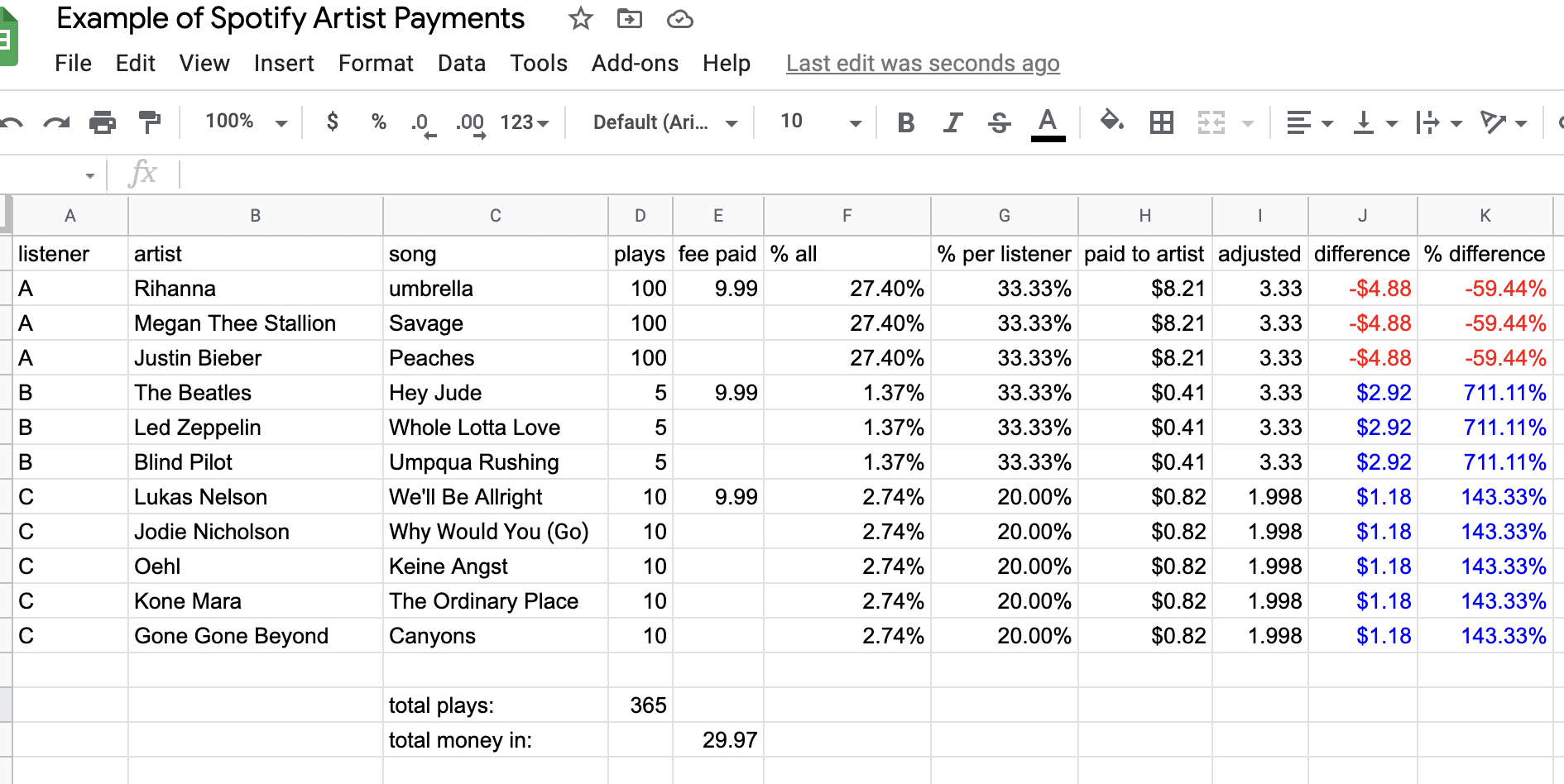
You may have heard something about the way that the Spotify algorithm favors mainstream artists at the expense of musicians with smaller fan groups. I decided to make a small spreadsheet to illustrate the problem. I know that for me it often helps to get a numerical representation of what is being discussed to help get my arms around it. It's one thing to say that listener dollars should go straight to the artists they listen to; that sounds logical and plausible and yes, we should do that. But until you actually run the numbers, it's hard to understand how important of a change that would be.
My first reaction to this idea of tracking listener payments directly to the artists that they listen to was basically a shrug. Doesn't it all come out in the wash? Why is that even a thing?
This QZ article is a good primer on why this is important. The arrangement, as it stands now, is called a pro rata system. What I am arguing for here is called a user-centric system. Let's run the numbers.

The crux of the issue centers around the idea that some listeners listen to more songs than others. Setting aside the fact that payment schemes differ between ad-based revenue for free users, and a portion of the monthly payment for subscribers, let's assume for one second that all listeners to streaming services like Spotify generate exactly the same revenue. If, in this case, all users listened to exactly the same number of songs per billing cycle, we wouldn't have much to argue about. The numbers would indeed come out in the wash — so to speak — and a pro rata system would look very much like a user centric system: every artist would have their listening stats tallied at the end of the month, and they would be paid according to their portion of that revenue pie. The thing is, we don't live in that world, and listeners have wildly varying habits in terms of how and when they consume audio streaming services. Because the 'value' of a given listen is not rated in any way, what can and does happen is that a certain segment of the listener group ends up contributing a very disproportionate amount of the listening stats in a given cycle. Every listen from a given user that is tallied beyond the average number of listens in that cycle (for all users) is essentially diluting the value of another, less-engaged user's listening habits. I know, that still sounds confusing. That's why we have spreadsheets.
If you look at the numbers above, I have it broken out into three listeners: A, B, and C. User A racked up 300 streams for the billing cycle. User B had 15, and User C had 50. This is pretty typical: if you are a Spotify user that listens at work, for example, you can rack up hundreds of streams in just one week. If you tend to engage with music just on the weekends, you might be more like user C. And if you are the kind of user that only shows up to listen to your favorite artist — or your favorite album — whenever the mood strikes you, your habits might look a lot like user B. The point is that in this sample scenario, user A accounts for more than 80% of the financial allocation for these musical artists. Out of the $30 that these three users are contributing to the payout pie, 80% of that will be attributed to the artists that are important to user A. The simple switch to a user centric algorithm would make a huge difference to the artists that are a little further down in the pecking order. 60% of the money that would otherwise go to artists that probably don't need it — like Megan Thee Stallion, Justin Bieber, and Rihanna — would instantly reallocate and constitute a huge bump for artists that just happen to have fans that aren't constantly listening to Spotify.
It should be a given that the revenue generated from a Spotify subscriber should go directly to the artists that user is supporting. Unfortunately that is not the case right now. If more of us as listeners and artists are aware of how important a simple change like this could be for the survival of indie artists around the world, maybe we can pressure Spotify into doing the right thing. As a database developer and web technician, I can absolutely understand that this is not a trivial adjustment to make from the standpoint of the application. But we owe it to all of the musicians that help make modern music such an eclectic and beautiful melting pot — musicians that work hard to bring new customers to these very profitable streaming platforms — to at least try to find a more equitable solution.
Justin Bieber doesn't need the money — but Kone Mara and Jodie Nicholson certainly do.
Cover photo by Alexander Shatov.